You´ve probably read about my Atlantic trip from Lisbon via Madeira to Lanzarote in previous articles. Some of my dear readers and most of my sailing friends did ask me this one question: “How was the Dufour performing?” People, especially in Germany where Dufour Yachts are a well known brand but there are only a few of them sailing around, are very interested in the sailing abilities, the building quality and the overall assessment on the French cruisers. Well, I´ll try to give an answer here.
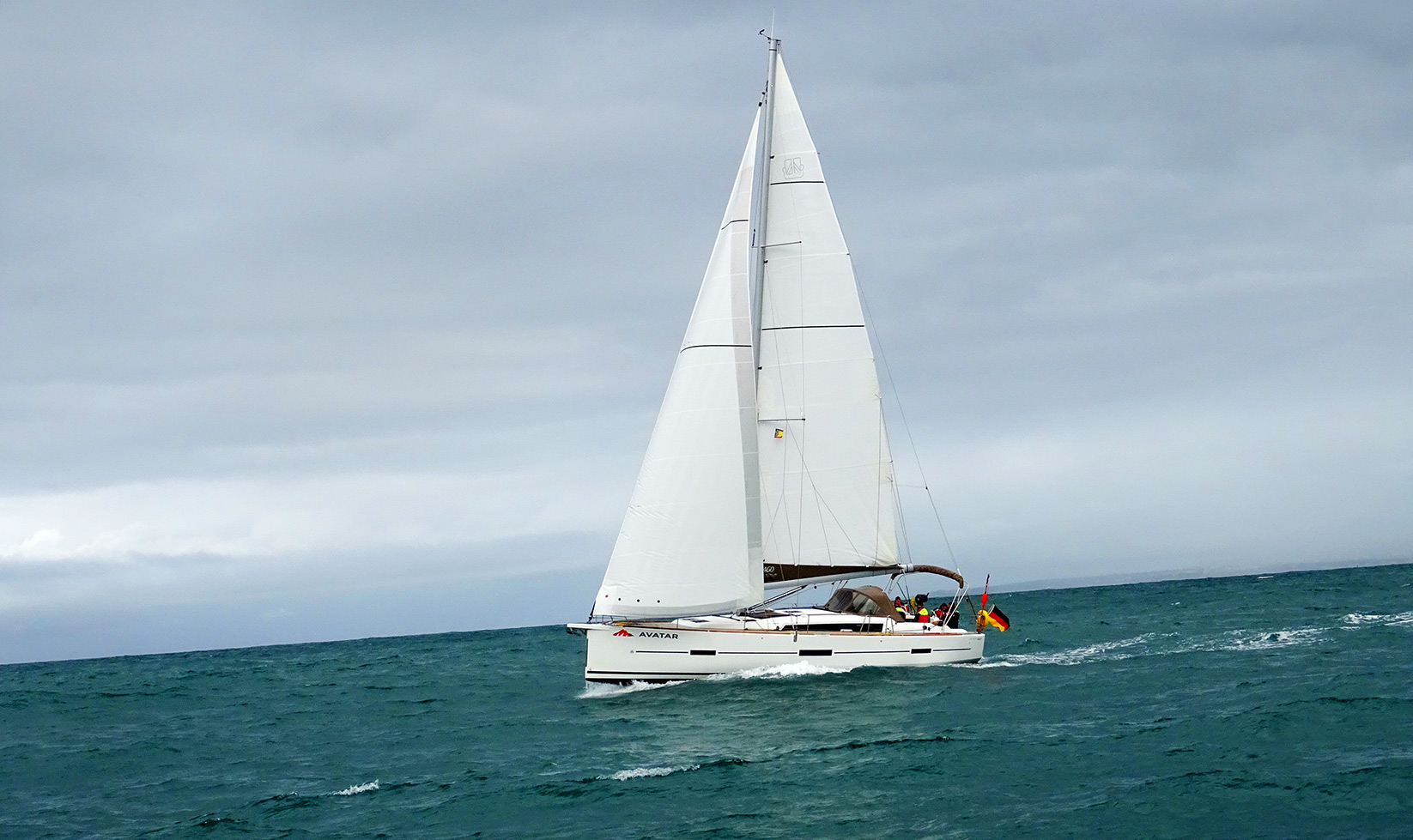
First of all: Dufour Yachts is an independent brand, producing some 400 boats annually and is thus one of the biggest production boat companies worldwide. Michel Dufour founded the enterprise more than 50 years ago with an emphasis on fast yet comfortable cruising boats – sailing characteristics have always been a major factor and attribute of the yachts. Besides: Did you know that Michel Dufour actually invented the inner & outer shell principle to make stiff hulls with GRP? I was sailing on a Dufour 460 Grandlarge – a 14.50 meters long cruising yacht of CE Cat A, 3 cabin-version. Now, let´s cast off and get up the canvas …
Hoisting sails & out on the Atlantic Ocean
We left Lisbon as part of a fleet of 6 brand new Dufour boats: Two of them being the 460, two 412, one 382 and the flagship being a 512. To make it short right at the beginning of this article: Each and every skipper and all of the crewmembers I spoke to assured me of the superior sailing qualities, the high speeds of the yacht even in lightest wind conditions and on every possible point of sail. This was my impression too: The yacht never ever dropped below 5 knots in light puffs and did speed up to 8.5 knots steady on a broad reach at 12.5 knots true.
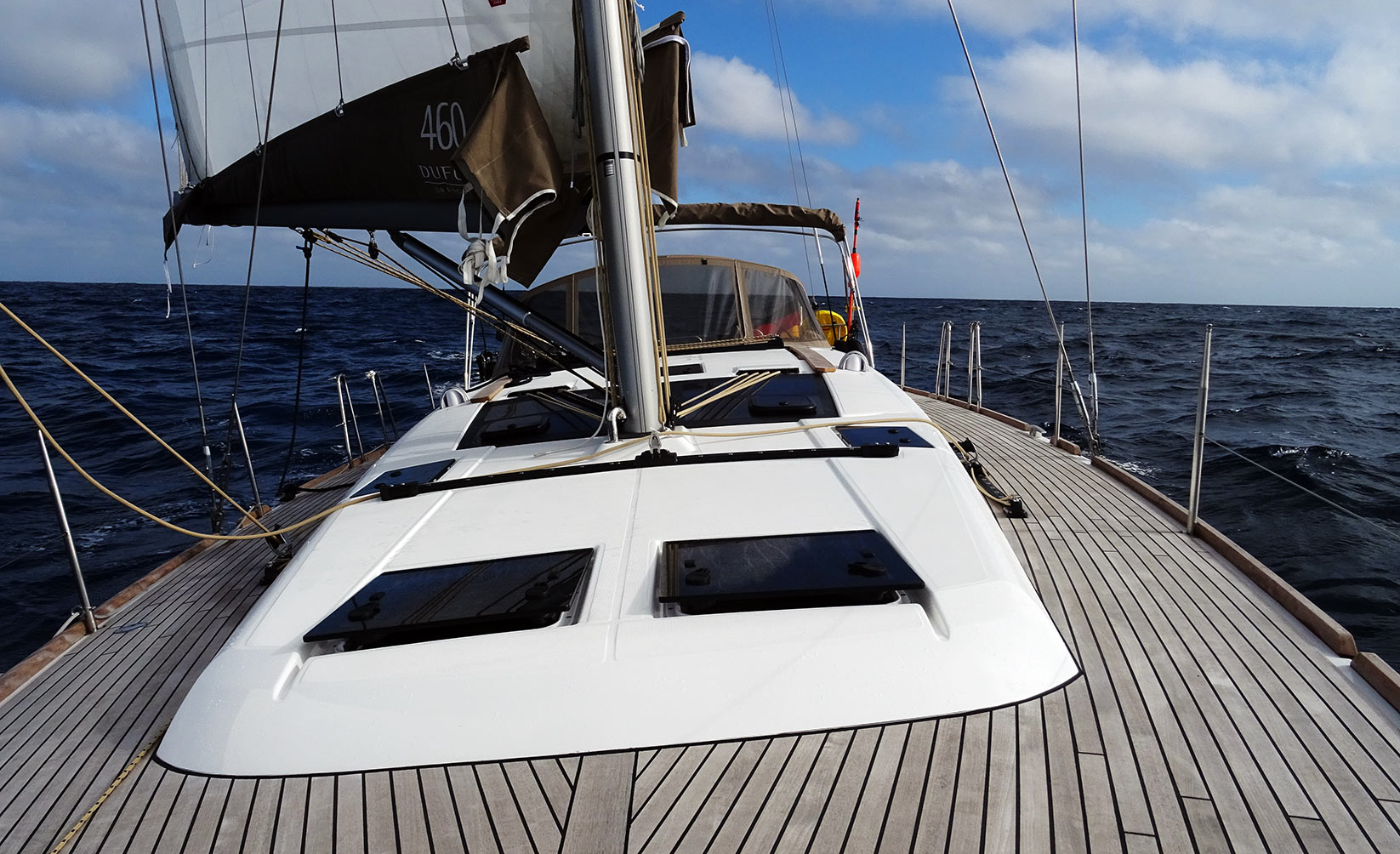
Sailing the 460 Grandlarge is a true no brainer as every line is diverted to the cockpit. Once the sails are up and trimmed, she will heel a bit, stabilize and run like hell. She will do this even in swelly conditions as we have proved many times with high and long waves coming from abaft, also with high but short and choppy waves coming from right aside.
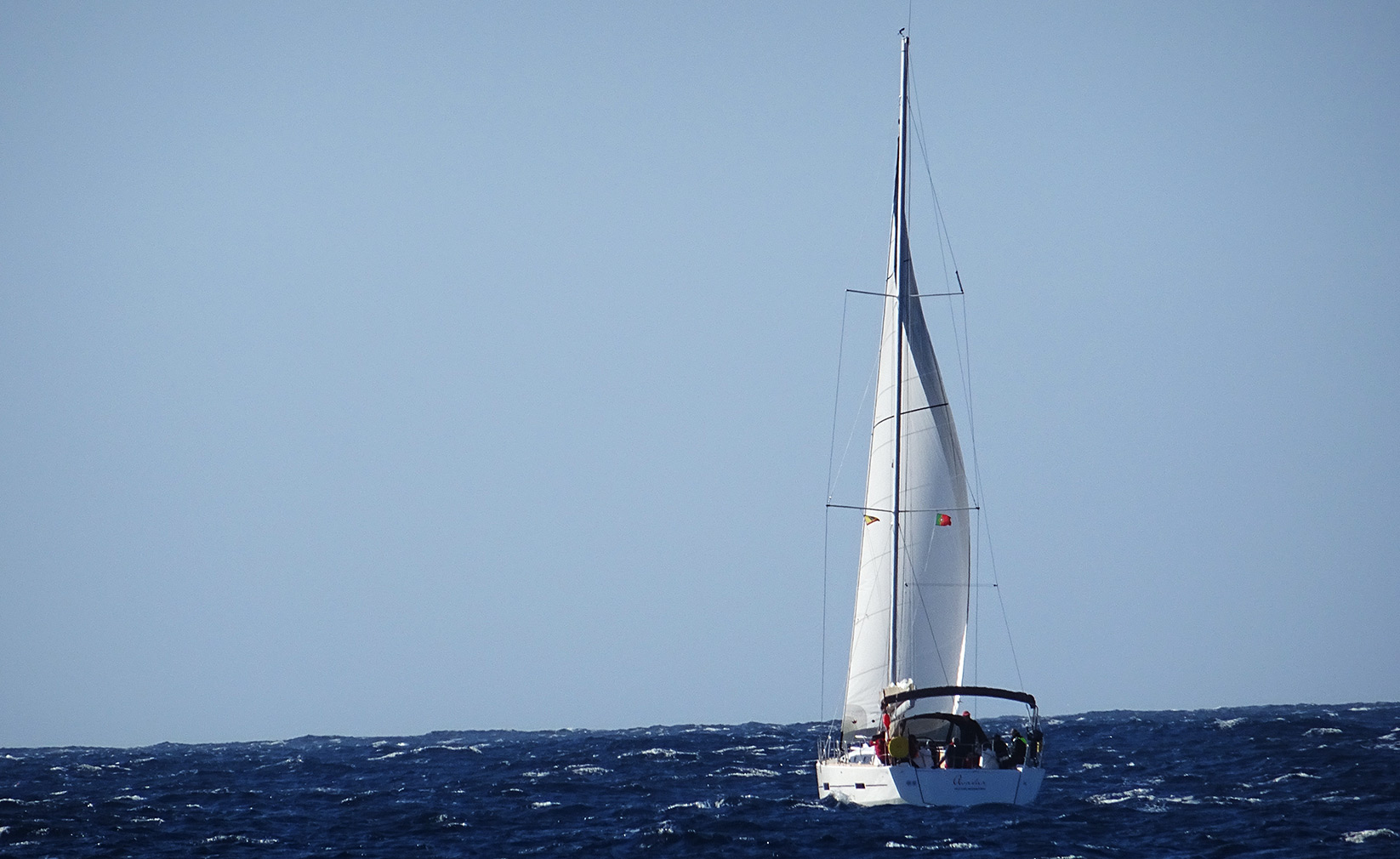
I can´t judge if this stability comes from her chines, I wouldn´t suppose that, but that´s the way it is: She sails much more stable than for example the more “rounded” IOR-hull of my own boat. On the helm she is very responsive. Even slightest corrections will be turned immediately into the new course – and this is done by a relatively conservative steering configuration. The 460 Grandlarge features only one single rudder where most of the similar sized yachts would feature double rudders.
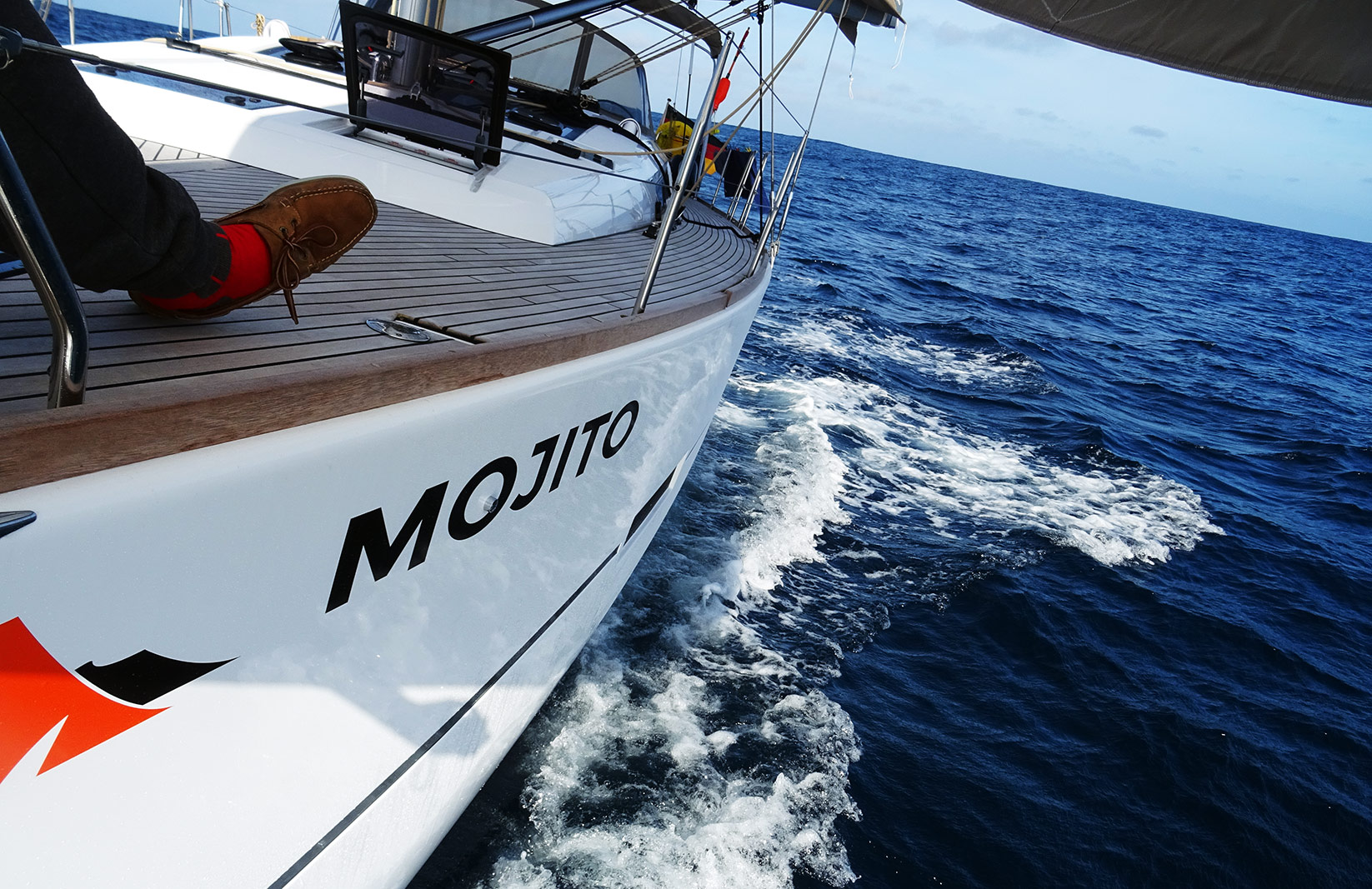
Designer Umberto Felci had therefore positioned the rudder blade slightly away from the stern and moved it forward to the keel to ensure proper steering even when the yacht should be heeled over heavily. We´ve never had any problems in helming the yacht, even once as she was suddenly luffing quite harsh in a gust two helmsman managed to bring her back to course without much efforts. Besides: the lines of the yacht are just marvellous!
At the helm of the Dufour 460: Steering the yacht
As I said before, steering the yacht is easy. It even gets easier ever more when you have installed an autopilot, which we had. It added to sailing pleasure in terms of easing the strains of a watch because in winds from behind steering is … some kind of boring. During daylight. When waves getting higher and winds push harder and the sun is down, it´s the other way round: Steering by hand is a complicated and very stressful task. It´s fun, of course, but you´ll have to learn it. On one of the Dufours the Skipper simply switched off the auto-helm and “forced” his crew to do it the classic way by hand. Much to the pleasure of the crew – people learned a lot on this trip. Well, we didn´t as our Skipper pledged to go the “lazy” way.

Helming by autopilot can be done principally in two ways: Steering related to the wind angle and steering by course over ground. The last is simple: You just put your finger to the waypoint you want to reach and tell the computer: “Go there!” The rest is done by the machines. You just have to check for traffic and the right sail trim. Steering to wind angle is interesting too as you can enter the very angle for which the sail trim is currently optimized. The boat will adjust its course to the shifting wind patterns. We´ve tried both and found the latter being the more “calm” way of steering as the boat didn´t needed too many course corrections. Steering to a certain course produces … noise.
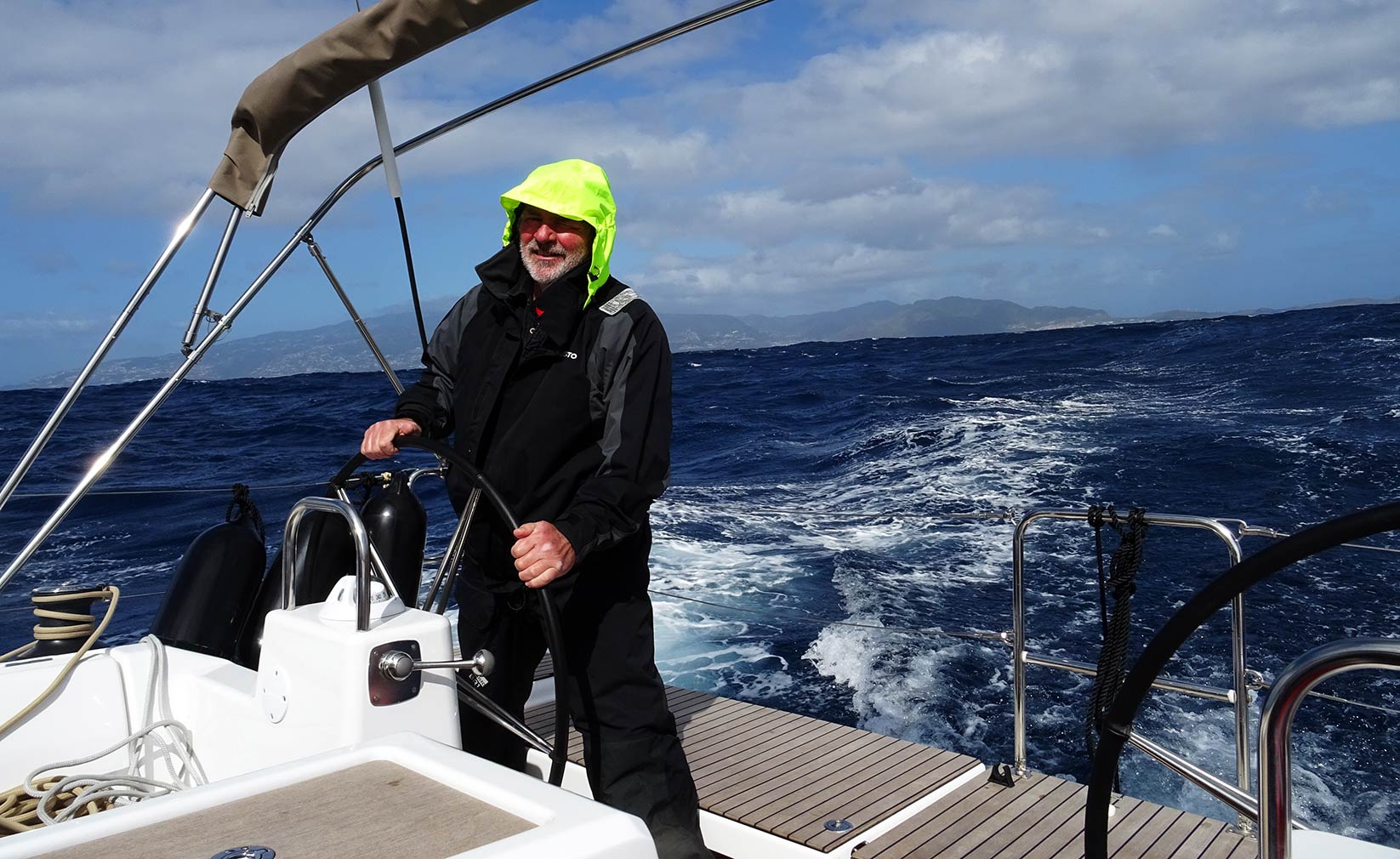
The electric motor that is connected to the steering mechanism has on our Dufour been mounted in the starboard locker situated right before the right steering column. Every course correction – no matter if done smooth and slow or hastily (in a gust) produced a loud vibrating sound which made it a very difficult task to find a good night´s sleep or just a some minutes of resting time in the starboard aft cabin. We therefore turned off the autohelm as much as we could. (Pro-hint: Do not ever forget to bring ear plugs to a sailing trip!)
Sheets, halyards & other lines on the 460 Grandlarge
Operating the lines and ropes is an integral part of sailing. On the Dufour Grandlarge yachts we instantly noticed the nice colour-scheme of the lines which is held in corporate colours beige, white and black. This in addition to the beige sprayhood, bimini and the great quality lazy bags produces a very attractive appealing design of the boat: I can think of other yachts where each line has another colour and in the end it´s a mess to look at. A salad of colours. Not so with Dufour. You will easily adapt to the colour coding to tell the halyard from a mainsheet.

Speaking of main sheets. As with most production cruisers, the Dufour Grandlarge is rigged with the German Mainsheet System by the yard. We all agreed that this is an odd way of roping and all crews simultaneously and independently decided to re-do the roping in this matter to bear the classic mainsheet configuration with putting the mainsheet to the cabin roof winch on starboard. As I did afterwards another rather short sailing trip on a 35 feet yacht equipped with German Mainsheet, I found it quite interesting to see how all is done by the helmsman from behind the steering wheel. So maybe there´s more to this German-style sheeting. I will take a closer look into this …

What I particularly liked was the electric winch that has been mounted on the cabin roof at starboard side. We used the winch to hoist the main sail and – apart from the fact that it had been forbidden by the charter company – to also furl in the Genoa and to work the traveller sheets to gybe. I actually did two gybes in the night all by myself with the help of the autohelm and the e-winch. It was a no-brainer! But beware of the sheer power of an e-winch! It can easily break a halyard and in case a finger (or two) will be caught by the line and sucked onto the winch … it can rip off a finger too.
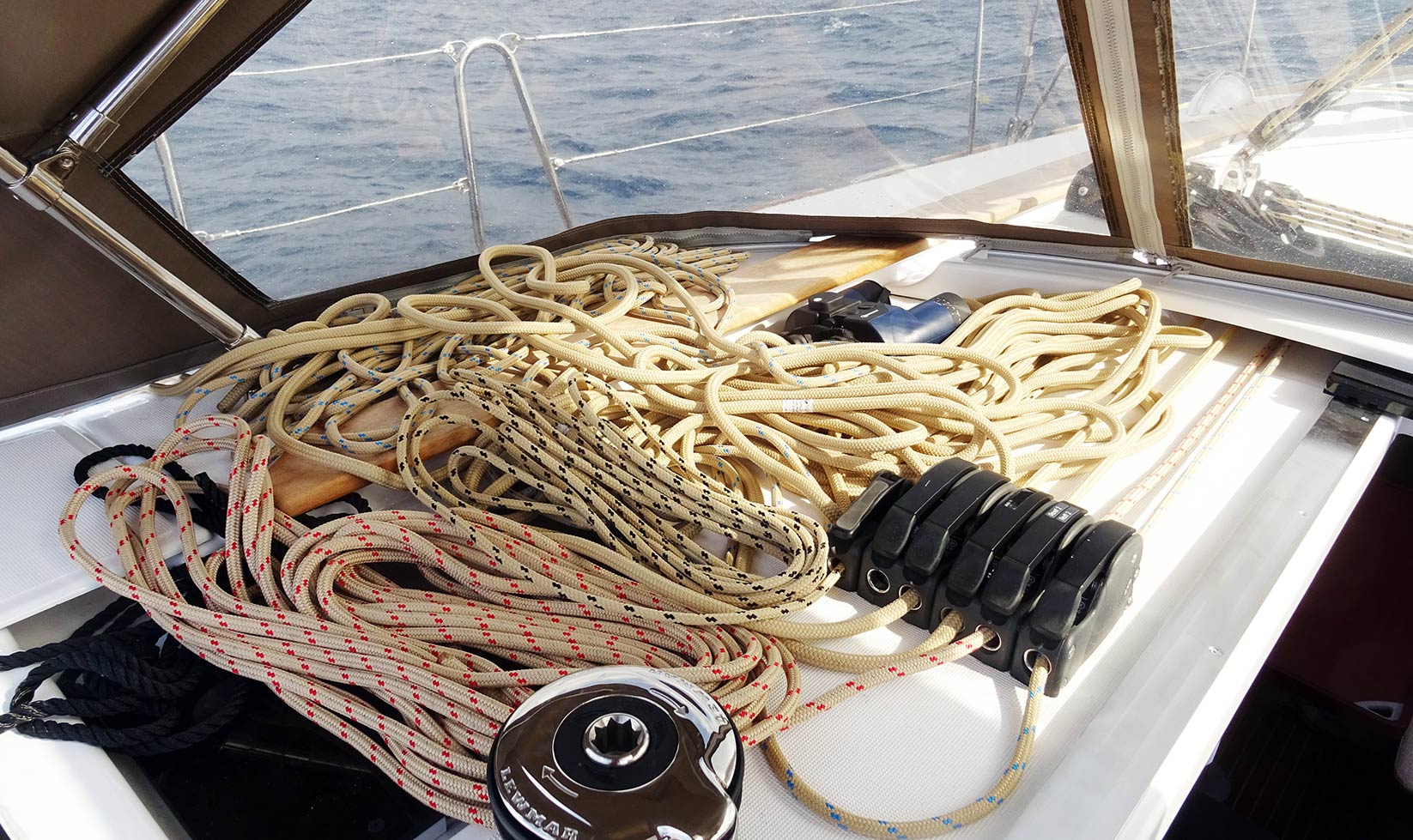
What I really disliked on our Dufour 460 was the fact that there is no place to put the lines to. Of course, that´s part of the owner (in our case the charter company LAVA CHARTER that bought the ships). On my own yacht there aren´t any line-bags nor compartments to have the surplus lines stowed (like it is done in the perfectly layouted Maxi 1200, read about it here) but I will let the lines fall down the entryway anyway: This couldn´t be done in our Dufour as we´ve had 5 persons on board and quite a traffic down below: In the heavy movement of the boat it would have added a hazard to the persons below deck. So I recommend every owner to take care of the lines anyway.
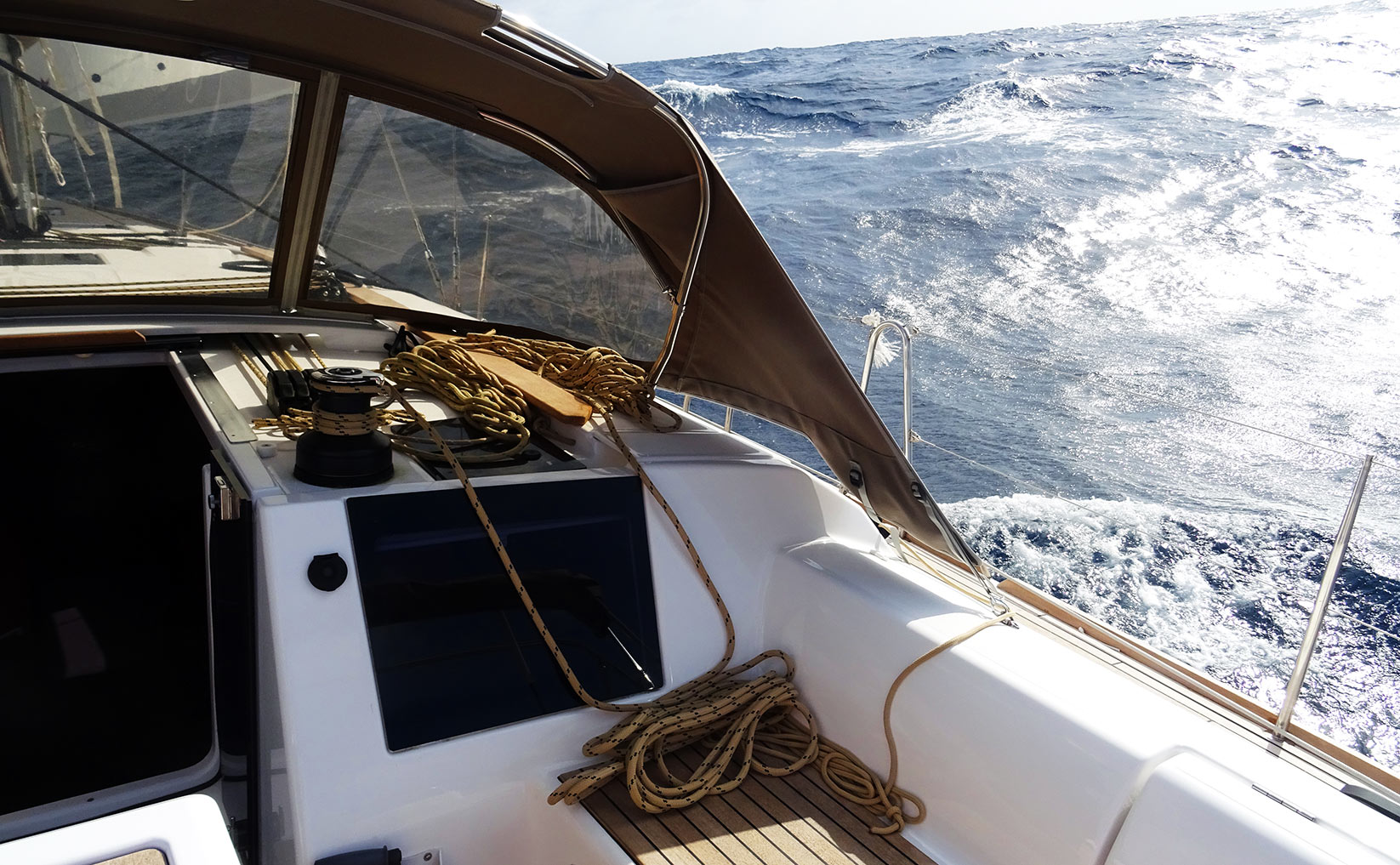
Aboard our SY MOJITO the solution was to have the surplus lines neatly coiled and stowed under the sprayhood. This had to be re-done on a daily basis because after every maneuver the nice coils had been messed up. Worse had been the fore sheets as there was no other place to put them but on the seating which took away precious space. Anyway, one must remember that Dufour is building cruisers meant mainly for having a leisure time sailing. Planning an offshore cruise or serious fast sailing? Sure, no problem, but this will mean you should add some details: Like line-bags.
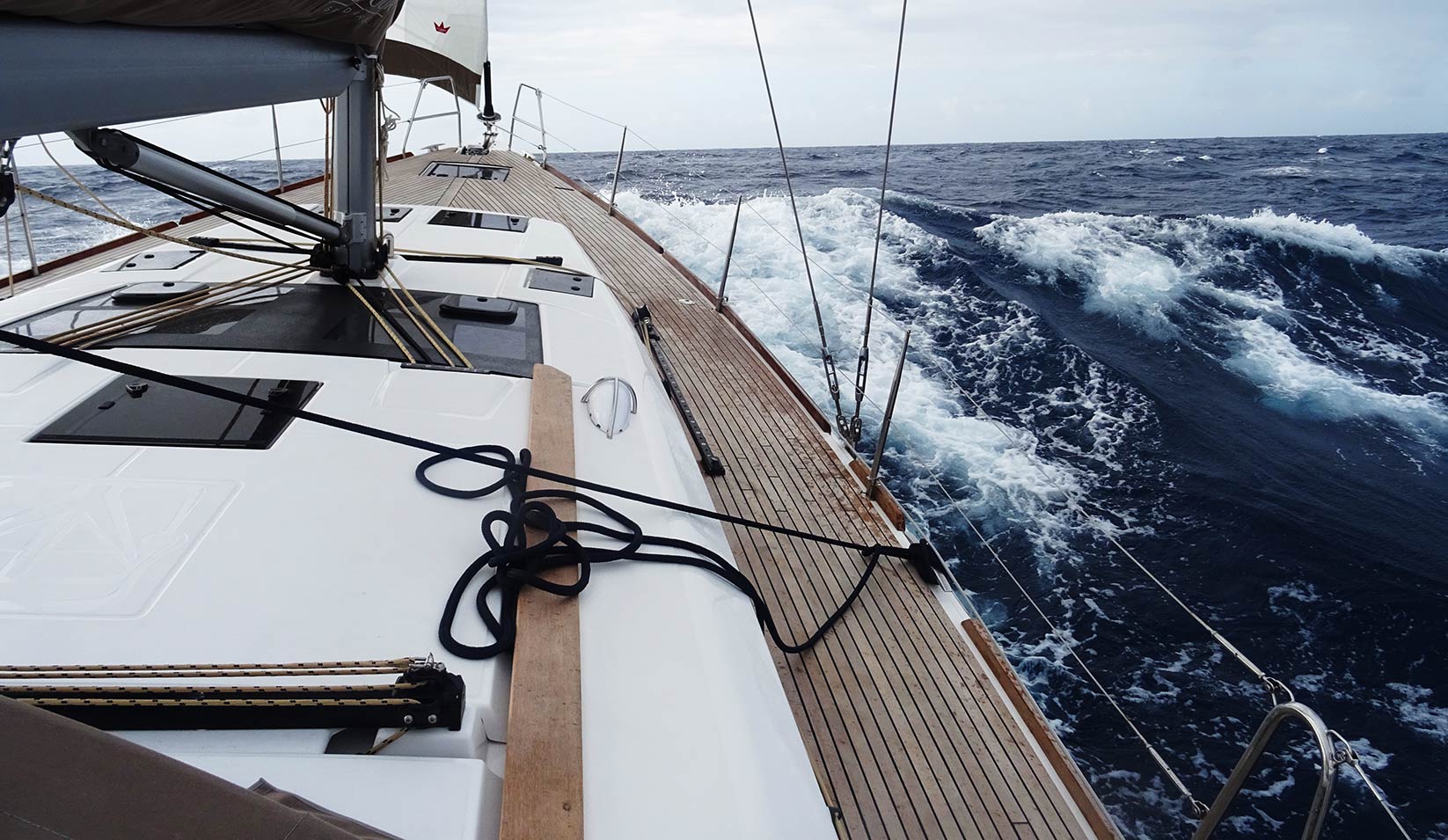
Speaking of a cruising-configuration: As we´ve had mostly winds coming from behind we were on a broad, reaching and sometimes even running point of sail. It´s essential – especially during the night! – to have a lazy guy. This was something we of course hadn´t have on our yard-fresh rigged Dufour so in order to have at least some kind of safety against an unwanted gybe I tied a line from the vang to the windward middle clamp. Not the most elegant solution but it added instantly to the yacht´s safety. And, besides, it prevented the vang from making noise when a sudden puff would fill the sails and cause it to bang.
Comfort and seakindness on the Dufour 460 GL
Sailing characteristics are of no question on all of the Dufours: That´s because renown naval architect Umberto Felci is the designer of the hulls. He uses to design serious racing-yachts, one-offs and very fast boats. When I got the chance to talk to him about his collaboration with Dufour he told me that he accepted the job under the terms that he would be allowed to make proper sailing yachts. So, it´s not headroom, standing height, volume or bunk-size that drives Dufour´s designs, it´s a fast sailing hull. But what about comfort then?
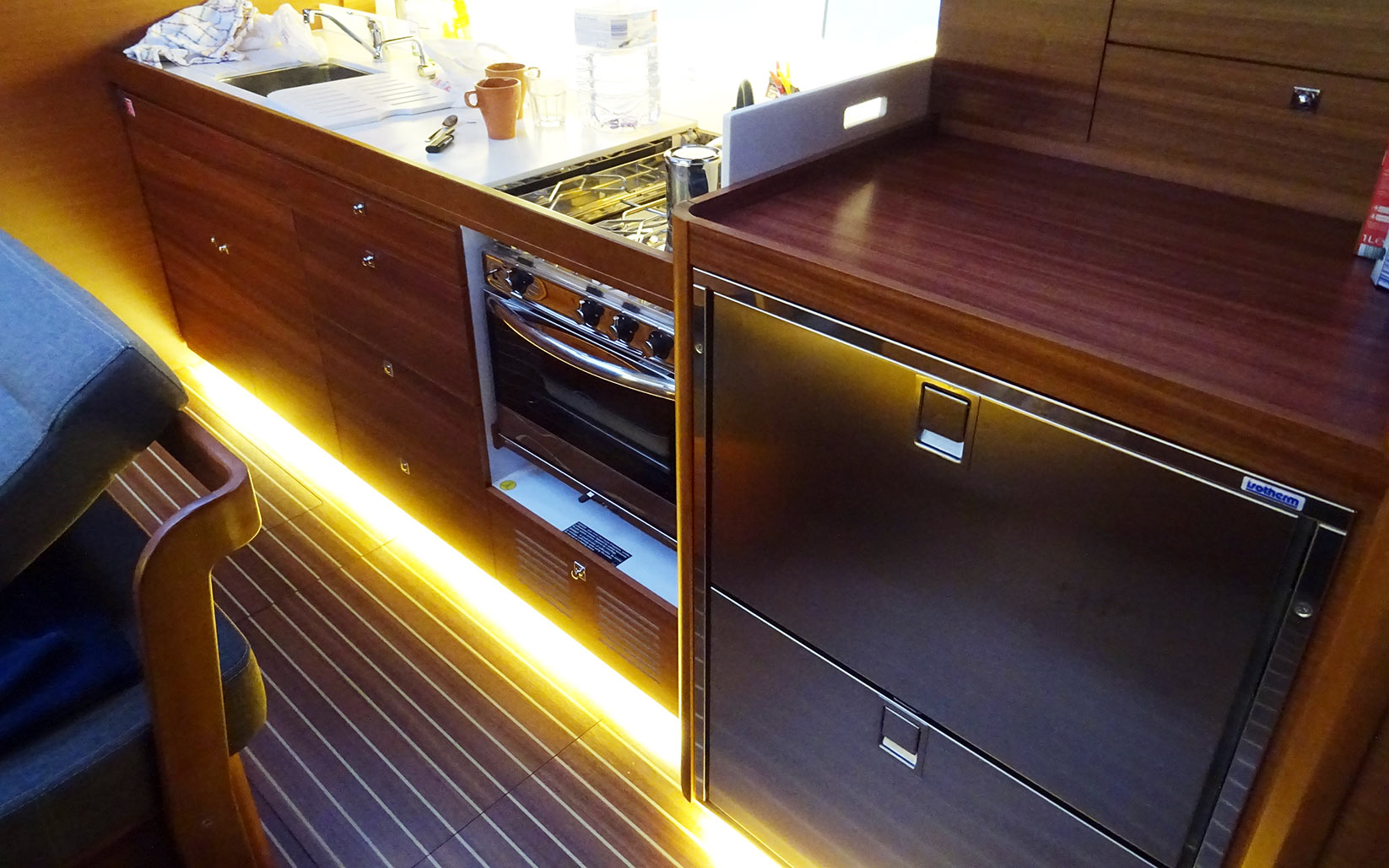
Well, the 460 – as every other Dufour – has plenty of it for sure. I much more prefer the 460 Configuration with the transverse galley – as you may see it in this article – but the classic longitudinal galley was also granting much space in the luxurious saloon. Cabin sizes are sufficient though one could add that other boats of this size will offer slightly bigger cabins for sure: But to a price we all know. Heating and venting was perfect. I loved the big dining table and enough seating on nice cushion to accommodate 5 persons and a large dinner with ease.
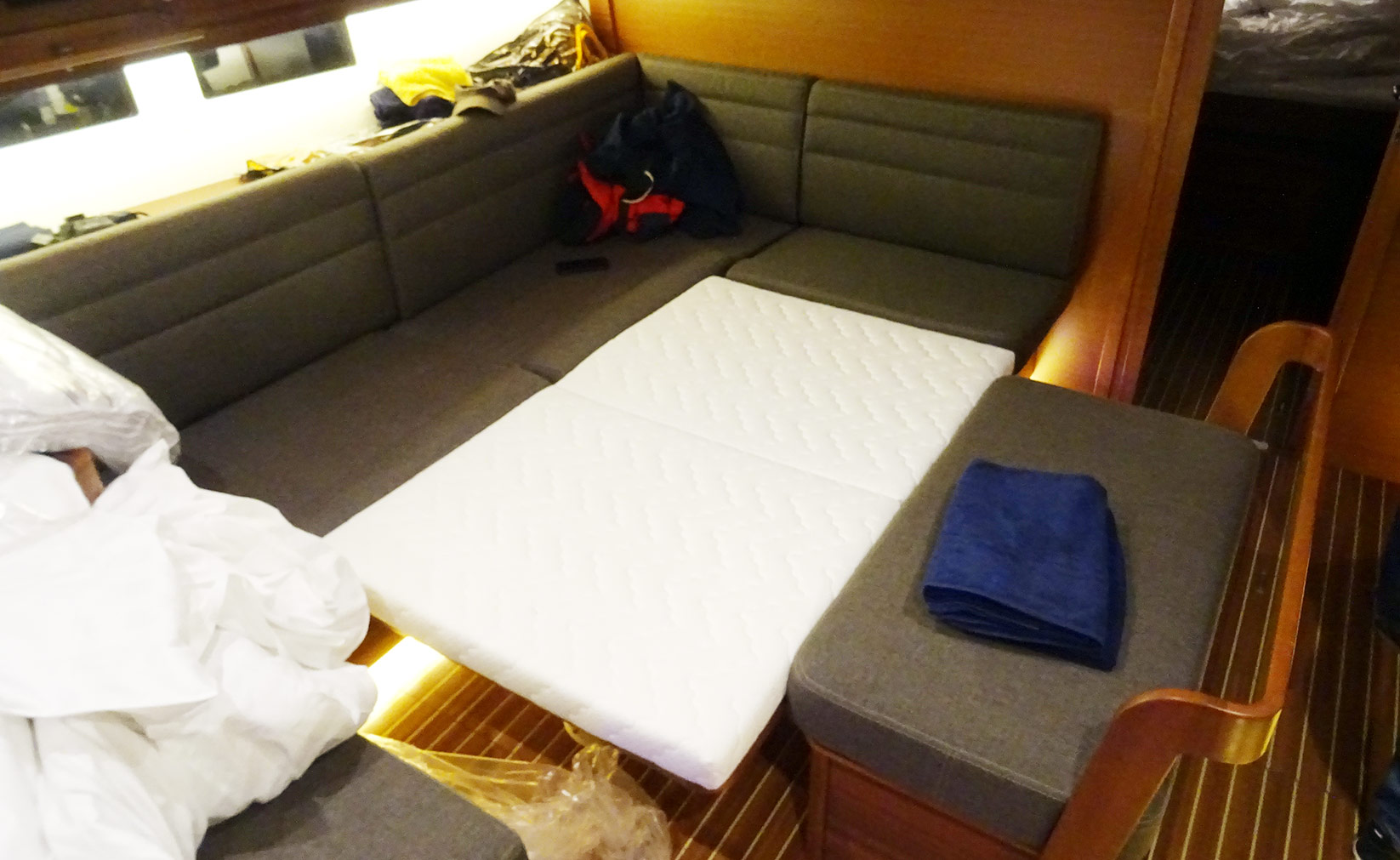
As a matter of fact, I had to sleep in the saloon (which I was perfectly fine with, especially during my 2 days of sea sickness), but as I was assured by some of the other crew members (one of them with a chronical spine-ache) the matrasses in the cabins of the Dufour are “state of the art”. One even said that he had never slept on better cushion in a yacht in his whole life …
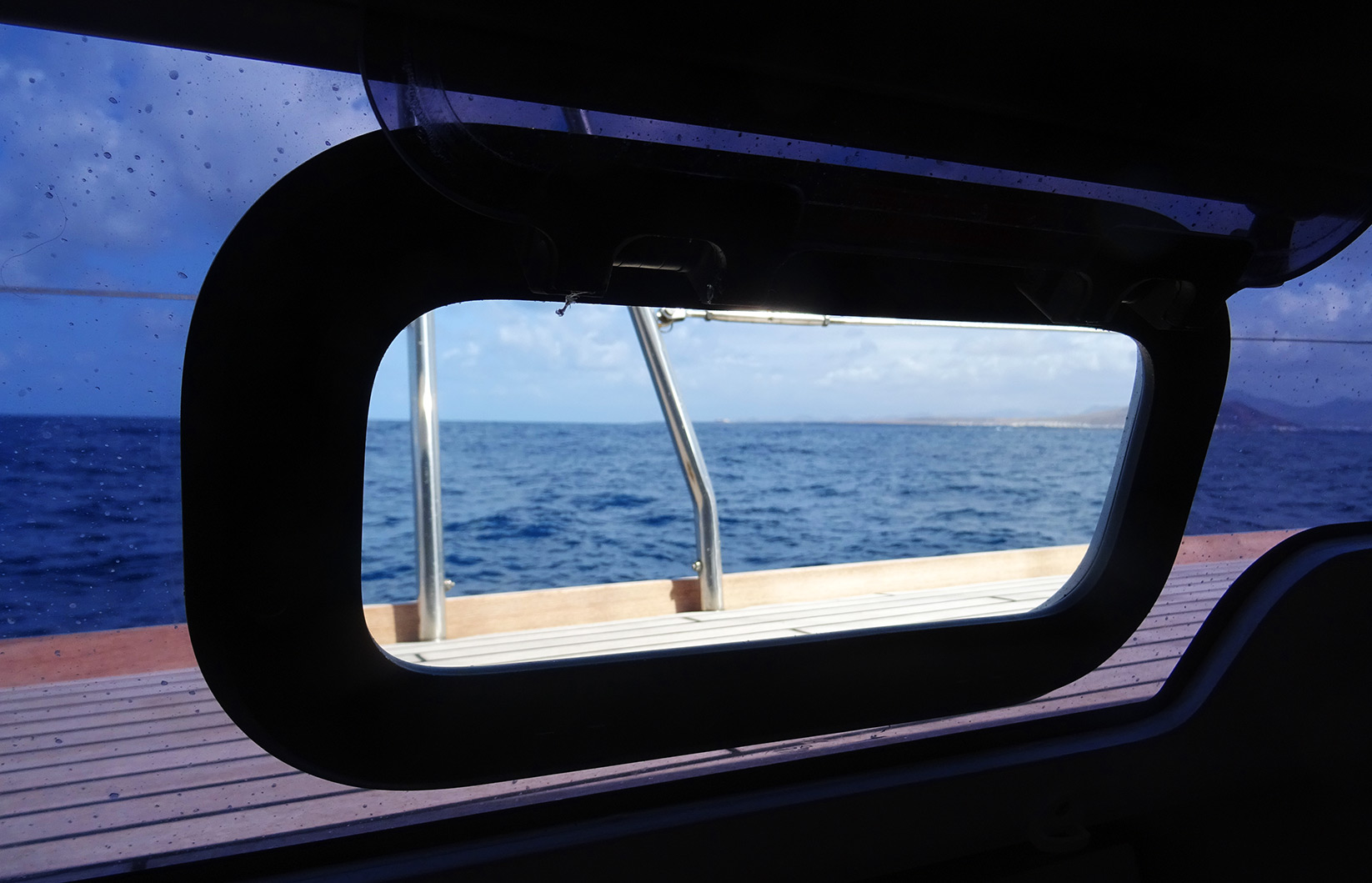
Dufour yachts are light suffused boats. That´s because of the fact that every yacht bears large skylights right after the mast, portholes in the ship´s side and a lot of windows in the cabin-roof and sides as well. Where other yachts just have plastic white ceiling covers to look at, the Dufour offers a grand view onto the sails or a beautiful night sky. All windows and portholes can be covered as well when in port of course. I particularly liked the LED-lighting concept of the Dufour: Especially at night the floor-LEDs could be trimmed in a way that there had been enough light for the crew to find their way through the cabin as well as for myself to find a good night´s sleep.
Downsides of the Dufour 460
So much praise and no downsides? Well, of course there are. As with every production boat the Dufour can suffer from this and that found on every other new yacht from a large company as well: Sometimes a screw was missing, on one boat a Sika-seam hasn´t been done quite nicely, we´ve had a missing heating system and – not Dufour´s fault of course! – on all (!) of the Elvström-mainsails every second mast-slider went missing during the trip as the material couldn´t withstand the forces of a killing sail during hoisting and taking down. In general, the quality of the built is comparable to other serial production companies such as Beneteau, Jeanneau or Bavaria, though I would say that I personally think that Dufour offers more wooden parts rather than plastic surfaces (like especially with Hanse). But that´s my personal impression.

Our yachts had been equipped with Teak in the cockpit as well as on deck. This work had been done quite nicely and I couldn´t find any spots, though on two boats we found small areas on which there hadn´t been done a proper sanding after attaching the Teak to the deck. But that´s all cosmetics. Of course, when it comes to the quality of the veneers on the inside furniture: One should be aware that this simply isn´t massive timber. Each scratch will be a mess that can´t be redone easily and one should be especially careful with knives and all sorts of sharp things.
Overall assessment: What a great yacht!
In the end, I can only join in to the praise of my fellow crewmembers after having sailed the Dufour 460 for some 930 miles as well as the Dufour 512 for some 20 miles: These boats are pure sailing fun! No matter if you have light winds or a sharp breeze, no matter if sailed with full canvas or reefed: The yachts live up to their image as a breed of the Felci-stable. They do simply sail like hell. All Skippers I talked to unison agreed that these had been the fastest cruising yachts they´d ever sailed on. Remember our fasted daily run (in light winds of up to 22 knots) of fantastic 163 miles! It´s not a racing yacht, of course – but a very fast classic leisure cruiser indeed!
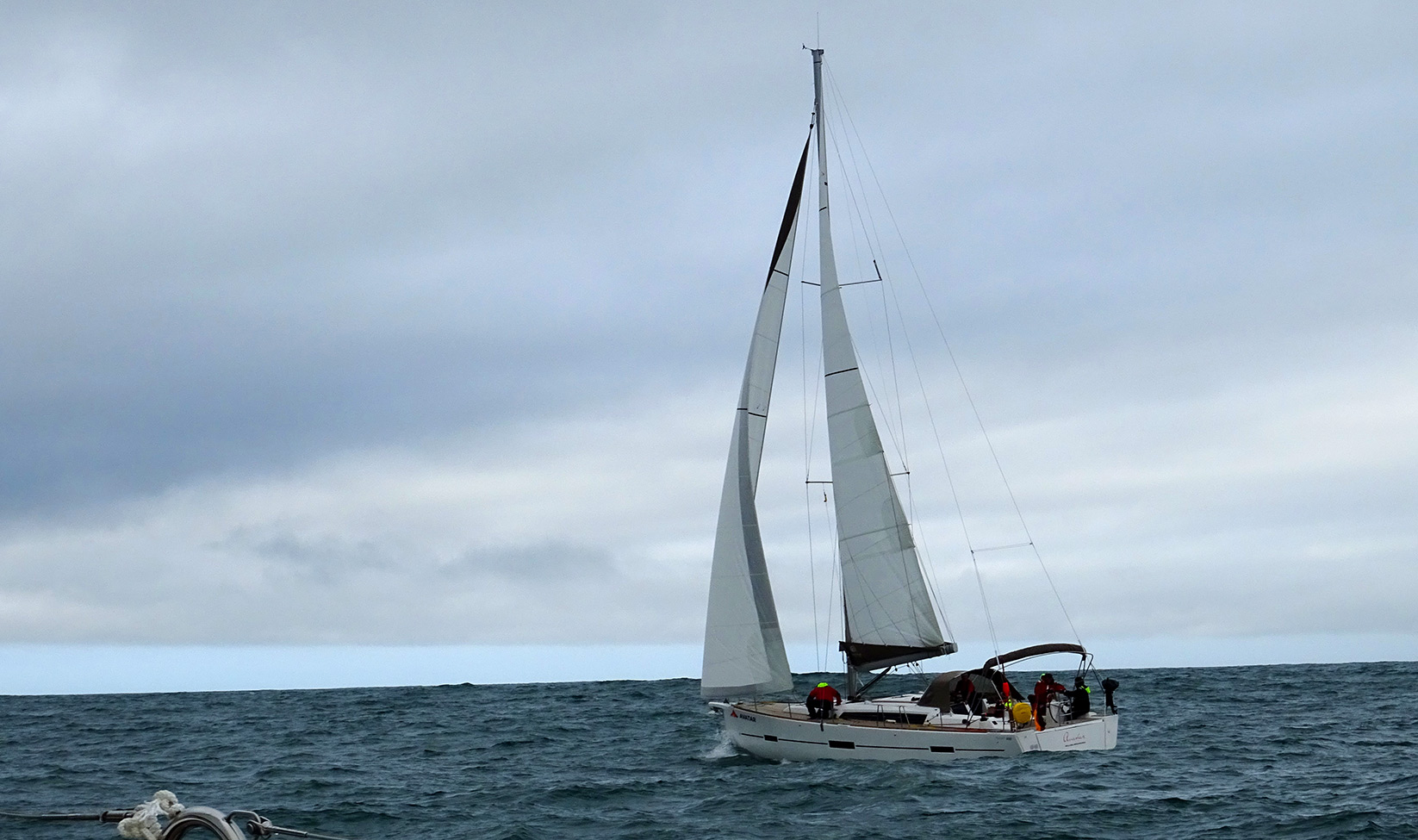
Dufour offers perfectly constructed sailing yachts of a slightly above average in the large production-companies-range. The boats are light-suffused, bear some very nice, though through details and solutions, offer a lot of comfort and feature a surprisingly large palette of basic fittings such as custmary self-tacking jib, German Main Sheet-System, JetThruster system (read it here) and for my taste a lot of internal wooden fittings. If you ask me: Anytime again I would board a Dufour 460 Grandlarge to sail out to the Oceans.
Related articles to Dufour Yachts:
Talking to Dufour´s chief naval architect Umberto Felci on the Dufour 63 Exclusive
A thorough inspection of the fast Dufour Grandlarge 310
All articles on the 1.000 mile Atlantic Cruise on a Dufour 460 Grandlarge
